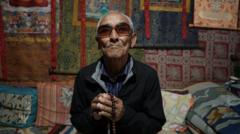Tibetans living in India continue to face an identity crisis that spans generations. The legacy of displacement weighs heavily on their hearts, as many seek a homeland they were forced to abandon in pursuit of safety.
The plight of Tibetans such as Tenzin Tsundue, a 46-year-old writer-activist, brings forth deep-rooted emotions linked to their status as refugees. They have navigated life in India under restrictive conditions, living with renewable registration certificates instead of proper citizenship documentation. Tsundue recalls the stigma in his schooling: his teachers used to draw attention to an "R" marking them as refugees.
Since the Dalai Lama fled Tibet in 1959 after a failed uprising against Chinese authorities, approximately 70,000 Tibetans have sought refuge in India, settling in 35 designated areas. Dharamshala, a serene Himalayan town, serves as the spiritual heart for many, housing the Central Tibetan Administration (CTA), which functions as the Tibetan government-in-exile. Despite their accepted status, the journey to self-identification is filled with challenges, particularly for younger generations who were born in India.
During the recent celebrations for the Dalai Lama's 90th birthday, deep reflections emerged among attendees, echoing the complexities of their stateless existence. Dawa Sangbo, who arrived in India in 1970, expressed his longing for his homeland despite having created a life for himself.
Among these Tibetan exiles, a longing for a sense of belonging permeates through experience and thought. Young Tibetans like Tsundue emphasize this reality, lamenting both their loss of a home and the inability to live freely within their homeland. Researcher Lobsang Yangtso highlights the trauma of statelessness, describing the psychological struggles it manifests within individuals who have never set foot in Tibet.
The challenges of statelessness extend into practical issues, as Tibetans face barriers in property ownership or employment opportunities that require Indian citizenship. Phurbu Dolma articulates a broader grievance, identifying complications with travel documents that are often not recognized abroad, complicating migration paths to Western nations that many are now exploring as potential avenues for a better life.
The CTA president, Penpa Tsering, notes that economic opportunities abroad often drive this migration, stating, "Dollars and euros go further than what's available here." However, personal motivations intertwine with these economic factors, as many are driven by the desire to reunite with family left behind in Tibet.
Despite the desire to return, many acknowledge the harsh realities under Chinese rule that make the prospect of returning unfeasible. The community's optimism, especially in light of the Dalai Lama's recent comments about his succession, offers a glimmer of hope, even as fears loom about the future and the sustenance of their cultural identity.
While Tibetans remain grateful for the refuge India has provided, the yearning for their homeland persists, a testament to the resilience of an identity that remains unresolved amid the landscape of global geopolitics. The future for Tibetans in India rests on a delicate balance of hope, cultural integrity, and the legacy of their enduring spirit despite the uncertainties ahead.


















